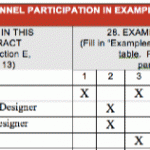Once I had an idea of what the website would look like, which you can read about in my previous post, it was time to get to the easy part…the words. Or at least that’s what I thought.
In my mind, words are important. With anything I do, I tend to focus much more on words and messages than on design. When addressing the words on our new site, I did a lot of thinking up front.
I Didn’t Forget About Goals
Let’s digress a little bit onto a seemingly unrelated topic…goals. What’s the point of updating the website if you don’t have a reason? The primary reason we were updating our website was simply that the old one broke. To give you some background, our site had been built in 2000 by a student at Drexel University. The cost of that site development was $2,000. Over time, the connection between our site (developed in Active Server Pages) and the database (a Microsoft Access database) broke. This happened partly, I suspect, because Active Server Pages became an outdated technology. Another reason was probably the web host migrating servers. But this broken connection was what prompted me to take this exercise on. But if I was going to update our website, I was going to do it right.
Now, I had been tracking data from our old website since 2005. For the most part, I was happy with the results of that site. I could identify several instances where work, initiated from someone visiting our website, came through our doors. We certainly got a good return on investment for that $2,000. In addition, I’m going to share with you some website analytics because I find that people rarely share this information. This will help me illustrate the specific goals I had in mind while coordinating the creation of content for this new website.
In my mind, I wasn’t very concerned with getting more hits on our website. We provide niche services, so there are not thousands of people a day searching online for firms like ours. But it was important to me that the new website get more visitors to become clients. In the web world that is known as “conversion.” To me, the first step to improve conversion was to reduce our bounce rate. Bounce rate is the percentage of people who go to your website and only look at one page. They “bounce” to another website. The average bounce rate, according to Google, is 47%. Ours was 41%. I wanted to get that down to 15%. It is a lofty goal, but sometimes you have to swing for the bleachers.
Another metric I wanted to improve was time on site. The average time on site, according to Google, is five minutes and 49 seconds. Our average time on site was two minutes and ten seconds. I wanted to get that to three minutes or higher. In order to do that, I felt our website had to be focused on valuable content that people would want to read. My visions was people would care about what they were reading. So every word on our website needed to be there for a reason.
I also wanted to get higher placement in Google search engine results. I observed many of our competitors simply keyword stuffing their way to the front of google searches. It didn’t make sense for me to play that game because it clearly affects the usability of your site. I also knew that with Google’s ever-changing algorithm, keyword stuffing would not be a long-term solution. In addition, I don’t have a ton of time or available resources to futz with the website. Therefore, I decided to “hang our SEO hat” on providing valuable content that people want to read. In my mind, the focus of any “search engine optimization” should be to become the most valuable resource for information regarding the challenges your firm helps clients solve.
As a side note, I spoke to a Search Engine Optimization (SEO) expert who provided me with an assessment of our old site. He concluded that there wasn’t much we could do related to off-page SEO. You see, Google doesn’t just look at the words on your site. It also takes into account who links to your site, the manner in which they link to your site, etc. So when relevant sites link to your website, that’s a good thing. That’s known as off-page SEO. This consultant referred me to the website SEOmoz.com which is a great resource for learning about Search Engine Optimization.
The three goals of reduced bounce rate, increased time on site, and higher Google placement tie closely with the text of your site.
I Also Wanted Our Text to Be a SUCCESS
I also wanted the text to meet certain criteria. These were concepts from the book, Made to Stick, which I think should be recommended reading for any marketer. The criteria was as follows:
- Simple – Meaning that it had to be easily understood.
- Unexpected – Meaning that the text had to grab your attention.
- Concrete – Meaning it had to use words that you could visualize. The words had to paint a mental picture.
- Credible – The text or claims on the site had to be backed up with evidence.
- Emotional – People had to be able to relate to the messages on a personal level.
- Stories – The text had to tell stories, because stories are the most effective way to communicate ideas.
All of these things weighed very heavily on what text would appear on the site. The next piece will center around how I addressed these text-related goals and criteria.
I’ve been getting great feedback from readers who say they are enjoying this series. If you have thoughts about this series, please leave a comment.





Speak Your Mind